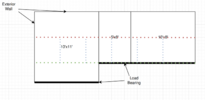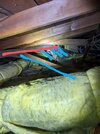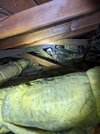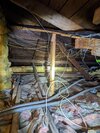- Joined
- 31 Dec 2022
- Messages
- 1
- Reaction score
- 0
- Country

First post and just a diy-er, but happy to learn.
In the photos below it looks like there is a crack forming in the purln (red line) that was called out by the general inspector when we bought the place. It was built in '54. I think it's happening because the supports (blue lines) are at too acute an angle and so don't really do anything. All of the supports are tied to joists at load bearing walls. Due to the layout, the one in the foreground has to go "further" to reach a load bearing wall. Roof joists and ceiling rafters are 2x6, 18" on center.
Would it be a problem if I built a strong back with part of it on top of the load bearing wall that currently is tied to the supports (blue lines) in the background, but part would extend over the area without a load bearing wall (the blue line in the foreground)? The part that would extend into the are without the LBW, would span to the next wall, which is an exterior wall. And then tie the purlin supports to that and then put in a purlin with supports at a less acute angle?
Diagram shows proposed strong back in green. New purlin rough location in red. And new supports in blue.
In the photos below it looks like there is a crack forming in the purln (red line) that was called out by the general inspector when we bought the place. It was built in '54. I think it's happening because the supports (blue lines) are at too acute an angle and so don't really do anything. All of the supports are tied to joists at load bearing walls. Due to the layout, the one in the foreground has to go "further" to reach a load bearing wall. Roof joists and ceiling rafters are 2x6, 18" on center.
Would it be a problem if I built a strong back with part of it on top of the load bearing wall that currently is tied to the supports (blue lines) in the background, but part would extend over the area without a load bearing wall (the blue line in the foreground)? The part that would extend into the are without the LBW, would span to the next wall, which is an exterior wall. And then tie the purlin supports to that and then put in a purlin with supports at a less acute angle?
Diagram shows proposed strong back in green. New purlin rough location in red. And new supports in blue.




